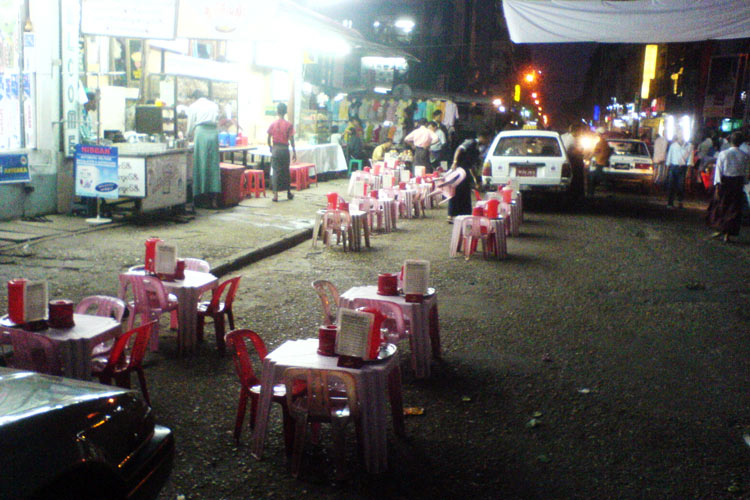I didn’t know what was ok to bring with me to Myanmar. When the rules are nowhere they are everywhere. “No professional cameras”, someone said. Surely 0.000 001 megapixels is unprofessional enough? So I built my own 1-pixel camera and danced confidently through the customs. I stared into 264 tea cups from south to north, from Yangon to Myitkyina, where my pocket accidentally deleted the camera.
This is how I, Erik, introduced the project, written on a small note lying on the floor among 264 postcard-sized prints of enlarged, colourful pixels ranging from pitch black, to numerous shades of milky brown and pale green, punctuated by the occasional hibiscus red or sky blue.
Swedish media rarely mentions Burma. In the autumn of 2007 this changed abruptly as the demonstrations, which fit perfectly with the media logics, was front-page news for several days and TV aired shaky clips of saffron-coloured processions filmed with mobile phone cameras from pavements or hotel rooftops. Reportedly, military intelligence raided hotels and seized mobile phones and digital camera memory cards from both foreigners and locals.
By the time I was ready to leave for Burma in mid-November the media was again quiet. Sporadic and sometimes contradictory rumours on web forums couldn’t confidently answer my questions. Can I bring my laptop or will the customs confiscate it? How about my camera and sound recorder?
This is when I had the idea of using a very small camera. Not small in size, but in information capacity; a camera that captures such a minimal amount of data that it cannot be considered a threat. Since no such camera was readily available (camera manufacturers are busy racing towards more megapixels) I made a program for my mobile phone that captures only the centre pixel of the camera viewfinder and saves it to a file in the phone’s memory.
Looking back, I realise I was both preparing alibis for (and perhaps wanting to provoke) a discussion with the authorities objecting to me photographing something unsuitable:
military man: You can’t take photos of this!
erik: Oh but I’m only using this 1-Pixel Camera. Look here (showing him the phone screen). All the photos are only small dots with one colour.
military man: Haha, I understand. No problem, carry on then.
This reasoning is not merely naive but also based on reason; that you are innocent until proven otherwise. In Burmese reality, if something is suspicious or just a little bit strange it is simply removed. Only later would I come to understand that similarly absurd dialogues (though usually with a not so happy endings) actually do occur when the censorship board comes to inspect the artworks at the gallery as described in the Timestamps section.
After exhibiting the printed pixel-postcards a Burmese friend wanted to write an article about the project, but said that the description I provided was not possible to publish due to the current political situation. For the first time in my career I was asked to present an alternative, politically correct, project description. (It’s actually amazing that he asked this as being the most natural question in the world. But of course, it was what needed to be done.)
So here goes: The 1-Pixel Camera is about making your own tools when you can’t find the ones you need. It is about memory, and how small fragments, a smell or a movement, can trigger vivid memories. It is about our urge to capture and store increasingly detailed data of our lives. For what and for whom? When will we actually browse through our gigabytes of films and photos? Some will remember a situation through the act of taking a photo, not by going back to the actual photo. Pressing the camera button and hearing the click of the shutter becomes a ritual that emphasises that this is a moment to remember. Perhaps the next step, then, will be a 0-Pixel Camera, a placebo device where the act, the ritual, is all that is left.
This is also a celebration of Burmese teashop culture. You never have to walk far to find a set of small plastic furniture on the pavement and hot, free, Chinese green tea waiting for you in a thermos. This is where you meet up with your friends, talk and gossip about the latest news. The 264 photos are fragments of such tea-shop conversations. The files are named to indicate the date, time and colour of the pixel. For example, when creating the file 20080105_155415_ff9c4929.png I was probably enjoying a lapeiye (strong tea sweetened with condensed milk) with Åsa in the afternoon Myitkyina sun on the first day of the Manau festival, where all the Kachin tribes gather to ‘dance their culture’, eat, gamble and celebrate their unity. Tiny reflections of Burma.

An unusually empty teashop in Rangoon
264 enlarged pixels at the semi-public Time Is in the Air exhibition in north Rangoon

The world in a tea cup